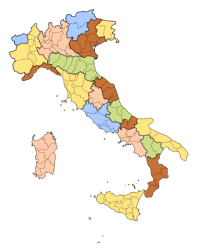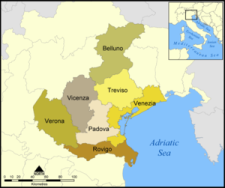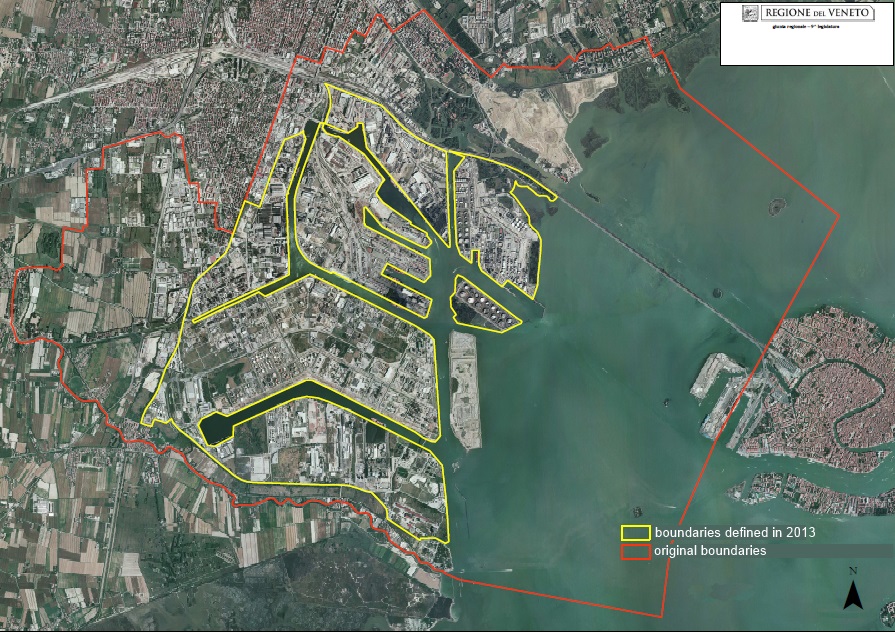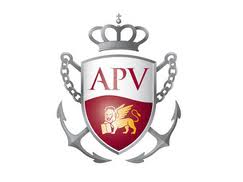Administrations and Authorities
 The Central Public Administration depends on the Government of the Italian Republic, who steers its general policies through the Ministries.
The Central Public Administration depends on the Government of the Italian Republic, who steers its general policies through the Ministries.
Local Public Administrations are administrative divisions of the State.
The 20 Regions of Italy are the first-level administrative divisions of the State, Regions are autonomous entities with powers defined in the Constitution.
Each Region is divided into Provinces; the 110 Provinces of Italy are the second-level administrative divisions of the State.
Each Province is divided into Comunes; the 8072 Comunes are the basic administrative division in Italy, roughly equivalent to a township or municipality in the English language.
The City of Venice is a Comune and is also Capital of the Veneto Region and of the Province of Venice.
The Veneto Region is divided into 7 Provinces: Belluno, Padova (Padua), Rovigo, Treviso, Venezia (Venice), Vicenza, Verona .
The neighboring Regions are, fron north to south: Friuli-Venezia-Giulia (in short Friuli), Trentino-Alto Adige (Trentino-South Tyrol), Lombardia (Lombardy), Emilia-Romagna; This Area is known as the North East of Italy and it is one of beating heart of the "Made in Italy". the Veneto Region is also bordering Austria
As for the Environmental Restoration and Industrial Redevelopment of Venice Industrial and Port Area, the competent Administrations are:
- Government (Ministry of Economic Development, Ministry of Environment, Ministry of Infrastructure and Transport and Ministry of Labor),
- Veneto Region,
- Province of Venice,
- City of Venice,
- Port Authority, that has powers equal to those of the City, within the boundaries of the harbor.
- Venice Water Authority, that is the permanent local unit of the Ministry of Infrastructure and Transport
The excellence in the Governance model for the Industrial Redevelopment of Venice.
Within a few years ago, the Industrial Area of Porto Marghera, with its 2,200 hectares along the board of the lagoon in front of the historic city of Venice, was one of the largest over polluted and, largely, decommissioned industrial area of Europe.
This Area is a mix of private properties, public land concessions both to private and public tenants.
Moreover, there is an overabundance of competent Administrations and Authorities: the Area is within the Port boundaries, which is inside the boundaries of the Site of National Interest, which is inside the Municipality of Venice, which is inside the Province of Venice, which is inside the Veneto Region.
Government, Region, Province, Municipality and Port Authority have independent and overlapping powers about the Territorial Planning and their powers can do nothing, without the will of the owners of the private land, to invest in industrial development.
Stakeholders have both complementary and conflicting interests and visions, that's why, in the nineties, nothing has been really effective against the industrial decommissioning of the Area that was, only two decades earlier, the most important in Europe for chemicals and polymers.
While the World was changing and the cost of energy was rising to unsustainable levels, compared to those of other Countries, the simple fact to be face to face to historic city of Venice was rising the cost of land to incompatible levels for industrial investments, legitimately feeding the hopes for real estate speculations of the land private owners and discouraging the bottom-up approach to lead the industrial redevelopment.
On the other hand, the Italian Government, facing the new issues of the European integration, of the Globalization and, at the same time, of the political commitment of assuring a certain degree of autonomy to Local Public Administrations, together with historic unresolved issues about the economic inhomogeneity of the Country, was able to allocate some resources useful to deal with environmental emergencies only.
In this Mexican standoff, where neither the top-down nor the bottom-up approach are effective to lead the industrial redevelopment, which kind of Governance can you possibly set up?
A third way was found, a Joint Negotiating and Consultative Committee (JNCC) and a Commissioner were the answer.
In Italy, Committees are used to be said are good assets if you want to go nowhere, but, surprisingly, not this time.
Somehow, the JNCC reproduced the unbelievable alchemy of the Italian political DNA, theorized by one of the founding fathers of the Italian Republic, Aldo Moro, that is the concept of the “Parallel Convergences”: one day, somebody points the finger to somewhere and everybody has to go there on its own.
The JNCC, with the name of “Permanent round table for Porto Marghera”, was established on 2006, just two years before the global economic crisis and, in spite of it, during these years, it attained achievements that were impossible during the 15 years before.
On 2006, the Port Authority was planning to push Venice as South Gate of Europe and was dreaming about a new concept of futuristic offshore terminal for large ocean-going cargo ships, combined to an inshore terminal for shuttle cargo barges, but it was complaining about the out of control costs of the land.
The Workers’ Unions were complaining about the out of control decommissioning of the Area, while the Trade Unions were complaining about the lack of competitiveness of infrastructures and for the out of control costs of energy.
Local Public Administrations were complaining about the lack of effective administrative tools and financial resources, while the People were complaining because the whole situation was out of control.
In spite of all this, everybody were conscious to be very close to the point of no return.
The director of “Venice Project” Department of Veneto Region took the lead and gathered all the local Public Administrations, the Workers’ Unions and the Trade Unions around a table with the objective to point out the strategies for the industrial redevelopment of the area and, just a few month later, the first Program Agreement was signed by all of them and the Ministry of Economic Development; thenceforth, round table became a permanent Joint Negotiating and Consultative Committee.
On 2013, The director of “Venice Project” Department was officially appointed as Special Commissioner, the JNCC produced the Project for Environmental Restoration and Industrial Redevelopment (PRRI), now ready to be signed by the Ministry of Economic Development, over 100 hectares are going to be made available for new investors, in the vision of innovative and sustainable industry, and the Port Authority is going to realize the new offshore and inshore terminals.
The weakest link of this model was the authorization process for the new investments.
the land remediation is up to investors, that’s not a problem, because its cost is offset by the higher value of the land; the problem is before you can proceed to the land remediation, you need to pass through the process of the environmental impact assessment (EIA).
The EIA tortuously involves all the local Public Administrations up to the Ministry of Environment, in a trail inspired by the Daedalus's maze; it could be a cost in terms of money, but, mostly, in terms of time.
That’s where the parallels converged: all the public administrations worked to streamline the procedures under their jurisdiction and the Commissioner worked to coordinate them, to help investors to have an easier process with less interlocutors; moreover, the reallocation of the 100 hectares will be managed by an Agency led by the Commissioner and the Municipality.
This model of Governance is a worldwide example of best practices and lessons learnt through years of experiences, failures and successes, and it is particularly valuable because is able to win against the legendary bureaucracy of Italy and the global economic crisis.
Site of National Interest

The Sites of National Interest, or SIN, are very large contaminated areas, classified the most dangerous by the Italian State and in need of remediation of soil, underground and/or surface water and groundwater, to avoid damage to the environment and health.
The SIN were defined by Legislative Decree 22/97 (Ronchi Decree) and the Ministerial Decree 471/99 and incorporated by Decree 152/2006, which stipulates that they can be identified in relation to the characteristics of the site, of the quantity and hazard of pollutants, the importance of the impact on the surrounding environment, in terms of health and ecology, as well as injury to the cultural and environmental heritage.
So far, the SINs identified by the Ministry of Environment are 57 (28 of them affecting the coastal zone) throughout Italy.
The SINs are areas where, as a result of human activities, it was detected an alteration of the qualitative characteristics of soils, surface water and groundwater, and in particular include:
- brownfield sites; industrial areas in the process of conversion;
- active industrial areas;
- sites affected by production activities and mining of asbestos;
- ports;
- areas that have been the subject of accidents with the release of chemical pollutants;
- former mines, quarries and landfills not complying with the law, illegal dumps.
The Site of National Interest of Venice has been defined in the Parliament Law No. 426/1998 "New interventions in the environmental field" art. 1, paragraph 4, as first in the list of those sites.
With the aim to simplifying the administrative procedures, on 24 April 2013 the perimeters of the Site of National Interest of Venice were redefined by the Ministry of Environment, excluding urban areas.
Special Law for Venice
On 16 April 1973, the Italian Parliament approved the Law No. 171, known as the Special Law for Venice, which attempted to comprehensively address the various issues related to the protection of the lagoon and the city of Venice, by placing them as objectives of national interest.
Over the years, the law was refinanced and extended and is still in force.
The planned actions are aimed specifically at reducing the level of pollution of the lagoon and waterways of the drainage basin, commissioning, safety and remediation of contaminated sites, redevelopment and industrial conversion of Porto Marghera (the Industrial and Port Area of Venice).
The guidelines for the de-pollution of the Venice Lagoon and its drainage basin (which covers approximately 2,000 square kilometers and includes 108 municipalities) are defined by the "Plan for pollution prevention and remediation of water in the drainage basin of the Lagoon of Venice - Master Plan", which is the regional planning instrument for the implementation of measures aimed at restoration of the lagoon water.
Six areas of intervention are identified, depending on the type of projects funded:
- sewerage system and water treatment area (works for reducing of civil and urban pollution, through the completion of the sewerage system and the improvement of wastewater treatment plants);
- aqueducts area (interventions aimed at the rationalization of withdrawals from rivers or wells of the drainage basin, to ensure a greater flow of the rivers and the reduction of potable water consumption);
- Territory area (interventions aimed at increasing the self-purifying capacity of the rivers of the Drainage Basin);
- Agriculture & Livestock area (with measures to reduce inputs of nitrogen and phosphorus in the lagoon, diversifying crops, revising agricultural practices and irrigation methods, optimizing the disposal of sewage);
- remediation of contaminated sites area (with specific interventions to be implemented mainly in the area of Porto Marghera and other sensitive sites within the Drainage Basin);
- monitoring and experimentation area (interventions aimed at verifying the environmental conditions and the development of pilot projects).
It should be emphasized that the considerable investment, implemented in recent years thanks to the funds of the Special Law for Venice, together with a more effective management of the system of protection, are leading to a substantial improvement of the environmental conditions of the lagoon ecosystem and of the water courses of the drainage basin.
Program Agreement for the Remediation
The need to simplify and speed up procedures for remediation of the National Site of Interest of Venice has been identified as one of the necessary actions to encourage conversion and re-industrialization of the Industrial and Port Area of Venice.
In 2010, the JNCC – Joint Negotiating and Consultative Committee (with the name of “Permanent round table for Porto Marghera”) identified the technical and administrative criticalities that were necessary to remove, in order to achieve, with fixed times and costs, the rehabilitation of the areas included in the Site of National Interest.
On 19 November 2010, the proposals drawn up by the JNCC, including those relating to the remediation, were illustrated and delivered to the representatives of the Ministry of Economic Development and the Ministry of Environment.
On 5 May 2011, the Ministry of Economic Development ratifies the recognition of "Area of Complex Industrial Crisis", meaning, in this way, to aknowledge the need to launch an integrated and coordinated activity for the re-industrialization.
On 16 April 2012, the Ministry of Environment and the Ministry of Infrastructure signed the “Programmatic Agreement for the Remediation and environmental restoration of the Site of National Interest of Venice and surrounding areas” proposed by the JNCC.
The Programmatic Agreement is the first example, at national level, of concerted action between Institutions for the conversion and recovery of a productive strategic area, it accelerates and simplifies the remediation of the Site of National Interest in Venice, not in derogation of any of the regulations.
The Agreement
- sets out the administrative procedures that allow to speed up the time of examination of the reclamation projects of the areas with the Site of National Interest, the principles and the detailed content of the technical documents of the projects;
- stipulates that the PIF system to be used for the remediatin of the water and the treatment of industrial waste water, with payment of the relevant fee by the users of the system;
- establishes a revolving fund for the remediation of the areas included in the drainage basin into the lagoon;
- defines the criteria under which the soil can be used in the presence of contaminated groundwater;
- defines the criteria for the return of the legitimate use of non-contaminated areas;
- defines the manner in which the City of Venice issues the permits to build;
On 21 January 2013, in Venice, the Minister of Environment has signed the operational protocols of the Agreement.








 Governance
Governance